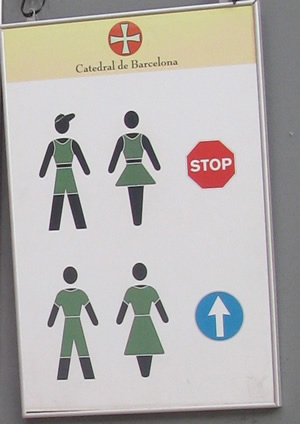Visiting the Barcelona Cathedral in Barri Gotic
Cathedral of the Holy Cross and Saint Eulalia (La Seu), also called the Barcelona Cathedral, began construction in 1280, but due to the black death, civil wars, and financial strife, was finally finished in 1913. And, you thought the over a hundred-year time line to finish the Sagrada Familia was a long time.

The Cathedral is a stunning example of Catalan Gothic architecture. But, the best part of any visit is to walk through the palm-strewn cloisters.

Tip: Try to visit at sunset when the sun lights the facade in a brown-red glow. Otherwise, pick a sunny day when the stained glass casts a colorful rainbow over the cloisters.
Warning: The dress code to enter the Cathedral is strictly enforced. If you plan to visit the Cathedral, make sure that you dress respectfully with your shoulders and knees covered.

Address: Placa de la Seu. Free, except M-F, 10:30-12:30 and 17:15 - 18:00.. See the official Cathedral website for more information.
Barcelona Cathedral Fast Facts and Highlights
Sant Crist de Lepant - On the first chapel on the right from the northwest entrance is a crucification figure of Sant Crist de Lepant. During a sea battle in 1571, the Christ figure dodged a cannonball and this was believed to be a sign from God that the Catalans would win the war against the Ottomans. The cross if from the front of Don Juan's flagship battleship at Lepanto.

St. Eulalia - St. Eulalia is the co-patron saint of Barcelona. In 304 A.D., this fearless 13 year old girl, went to the Roman governor and told him to be nicer to the Christians. The governor did not want to be lectured to by a 13 year old, so he sentenced her to as many gruesome punishments as her age (13). A few of the punishments were:
- Flesh torn with hooks
- Lashed.
- Put inside a barrel with glass and nails and pushed down a slope behind the cathedral.
- Placed in a box with hungry fleas.
- Wounds sprinkled with boiling oil.
- Nailed to an X cross in the Placa del Pedro in the Ravel.
- Cut-off breasts.
Her final punishment was a beheading. When her head was chopped off, a white dove flew out, a sign from God that Eulalia was a saint for her martyrdom.
You can find the " X" symbolic of the cross she was nailed to carved on pews. Go down stairs to find her gold tomb.

Saint George - Find the tiny statue of Saint George slaying the dragon. He is the other patron saint of Barcelona and the most popular boy's name in Barcelona.
Cloisters - The cloisters are chapels sponsored by various Barcelona tradesmen. There are numerous cloisters in the Barcelona Cathedral, since each chapel meant more money for the church.
On the pavement stones, find the symbols of the various trades and guilds. Look for scissors, shoes and bakers.
The 13 Geese - Look for the 13 geese. The geese are different from geese in the States. Instead, they are Roman geese. You can tell by the tufts on their heads. The geese act as alarms for the monks by honking. The number 13 refers to the age of St. Eulalia and her 13 punishments.

Sardana Dances - The Sardana is the Catalonia national folk dance that anyone can join in. It takes place on Sunday at noon and Saturday at 6:00pm.
Roof - Take the stairs or the elevator to the roof for a dazzling view over Barcelona.









